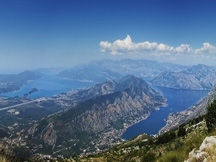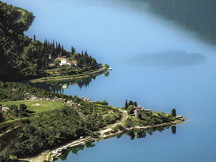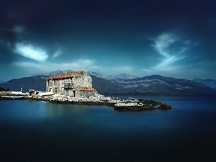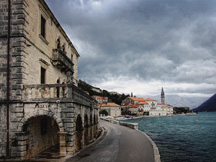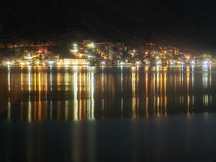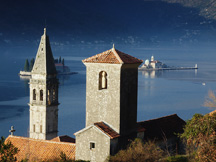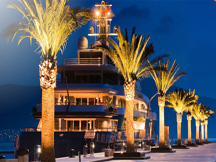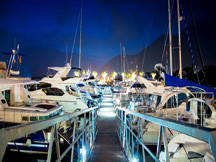Boka bay, the bride of the Adriatic ...
Whoever visit Boka he or she experience it on a special individual way. No matter whether we are talking about artists, scientists,
businessmen or tourists, Boka performs strong impression on all human senses. Boka is a place where various differences meet up and
mix up by creating an entirely special ambiance. Contrasts are replicated in nature where in one part of the bay one can see steep
rocky mountains rising upon the calm sea surface, while on the other part flourish real botanical gardens. Contrasts are also
emphasized in the cultural-historic heritage where two civilizations of east and of west meet upon each other in a special harmony.
Prehistoric age, Iliric age, Roman - Byzantine age, renaissance, baroque, gothic styles all that is melted together and blended with
the modern life, showing that the real valuables last forever together in harmony.
Total surface of the bay: 87.3 km2 , volume: 2.4 x 106 km3 , maximal depth: 60 m, average depth: 27.3 m, water salinity: 28%, total
length of the coast: 105.7 km. The bay of Boka Kotorska penetrates 28 km deep into the land area.
Boka is bejeweled by seven islands; Mamula, Sv. Marko, Gospa od Skrpjela, Sv. Djordje, Milosrdja, Ostrvo Cvijeca and Mala Gospa.
Along the whole coast of Boka there is a chain of small towns and settlements all of which has its own story.
From the south-eastern side the bay is surrounded by the karst massif of mountain Lovcen (1749 m). From the north-west side by the
karst massif of mountains Orjen (1895 m), Radostak (1446 m) and Dobrostica (1570 m). Between above two massifs just above Perast
spreads karst massif Kason (873 m).
Peninsula Lustica is located on the south eastern side of the entrance to the bay, while the Vitaljina peninsula is located on the
north-western part. The two peninsulas are separated by the channel Ostro. In the inner part of the bay there are two more peninsulas
Vrmac and Devesilje separated by the strait Verige. Strait Verige divides Boka Kotorska bay on two frontal bays: bay of Herceg Novi
(former bay of Topla) and bay of Tivat; and two internal bays: bay of Risan and bay of Kotor.
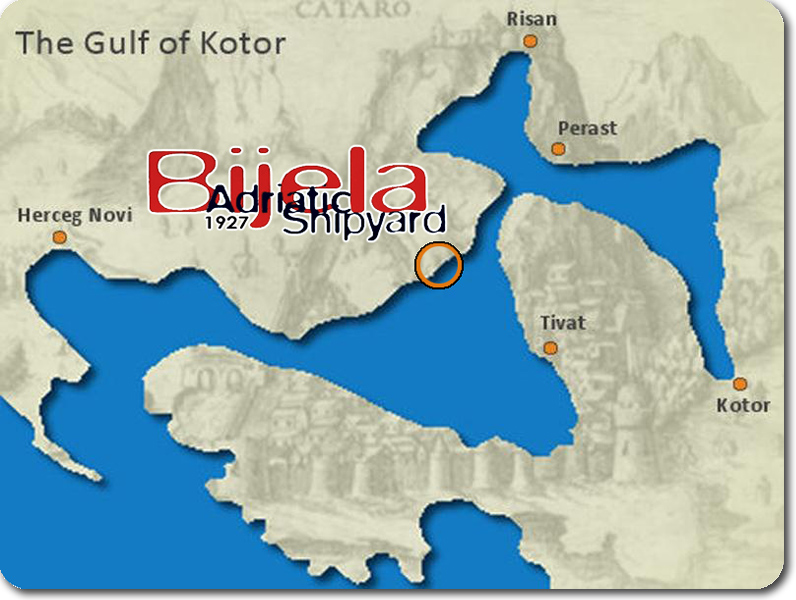
The region of Boka Kotorska, observed as a geomorphological and geovegetational entity is enormously wealthy in nature with special
characteristics creating quite unusual contrasts in the relief, vegetation and stone structures.
Located between the Adriatic Sea and the vide limestone area the region of Boka Kotorska is under a strong influence of Mediterranean
and Mountain climate. That special climate blend creates a distinguished Sub-Mediterranean climate quite different from other part
of Montenegrin coast. Unique feature for Boka is the early spring when all surrounding mountains are still covered with snow while
the coast flourishes with Mediterranean trees and flowers in blossom. During the winter one can enjoy the pleasant sun and calm
weather on the coast while to the mountains and snow takes just 1 hour of slow drive. Summer season in Boka is pleasant with a
little bit more rain especially in the internal area, than in other parts of the Montenegrin coast, which is on the other hand
reflected in dense vegetation. The most of the rain in Boka falls in the late autmn and partly during winter. Along the whole coast
line of the bay exist the rich distribution of Mediterranean, continental and exotic vegetation such as laurels, palms, olive-trees,
orange and lemon trees, pomegranate trees, agaves, camellias, mimosas… This is just one part of Boka’s wealthy flora.
Interesting stories about Boka Kotorska bay you can find on world-bays.com and bestofboka.com
Perast
The Boka Bay (Boka Kotorska) cuts deeply into the coastline of the southern part of the Adriatic, creating four spectacular bays
ringed in mountains, the “fjords” of the Mediterranean. The little town of Perast is situated at the foot of St. Elijah Hill (873 m),
at the opposite of the narrow Verige strait, where the innermost bays of Risan and Kotor converge. This easternmost shore was the earliest
inhabited area in the Boka. The remains of a Neolithic culture (3500 BC) have been discovered in the caves of Spila above Perast and
various archeological finds provide evidence of civilization dating from Illyrian, Roman and early Christian periods.
With two front jewel-like islands, Perast is focused on the sea. From the interaction between mainland and bay, the inherent contrast
of stone and water, the dialogue of island and wave, sometimes in harmony but often in conflict, this sea-faring town has derived its
unity, strength and sense of purpose. Despite its size, a sophisticated urban structure has arisen, demonstrated by the proportion, scale,
massing and rhythm of the great number of public buildings, especially along the waterfront.
Tivat
Tivat nestles in the heart of Boka Bay, with its wonderful coastline with many beaches, coves, harbors, and in the great part undiscovered
with very attractive hinterland. The rich archaeological findings and cultural and historic heritage testify of its early beginnings. Various cultural
programs, popular festivities and sports events have become synonymous with the town. Thus, its special features are its people, hospitable
and open for all curious guests coming in good faith. And our visitors with pleasure return, some for the sake of the well-preserved coastal
setting and some for the sake of the atmosphere of hospitality and relaxation.
Oficial web page of Tivat Tourist Organisation is on address tivat.travel.
Porto Montenegro project is the construction of settlements around the marina and the home port for yachts with great perspectives designed
to meet the sophisticated needs of all the yachts, their owners, guests and crew, with the additional infrastructure for the largest yachts.
The main investor of the project is a Canadian businessman Peter Munk, founder of Barrick Gold Corporation. Other investors are Lord
Jacob Rothschild, Nathaniel Rothschild, Bernard Arnault, Sandor Demjan and Anthony Munk.
Oficial web page of Porto Montenegra is on address portomontenegro.com.

